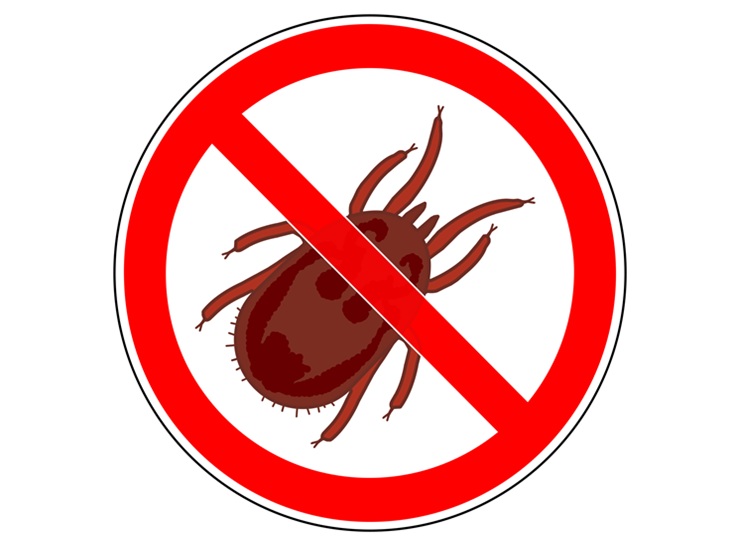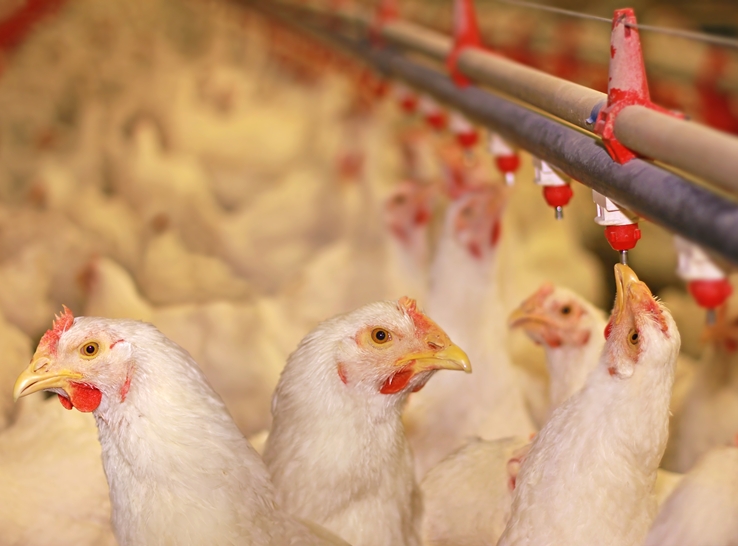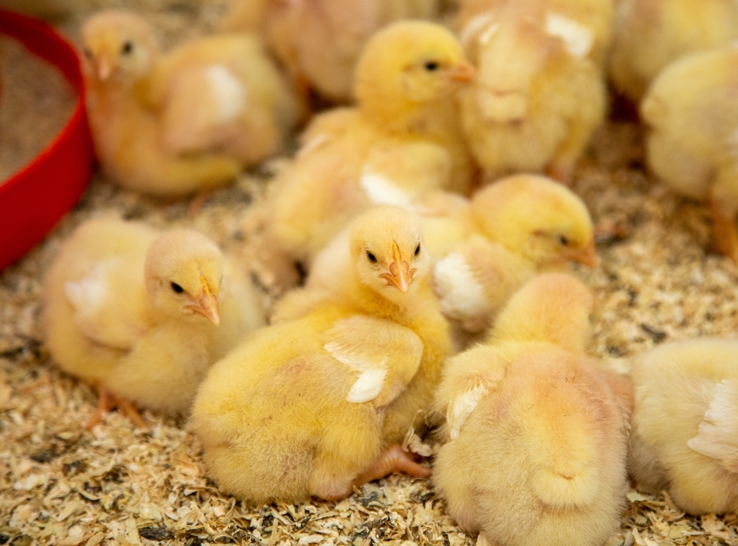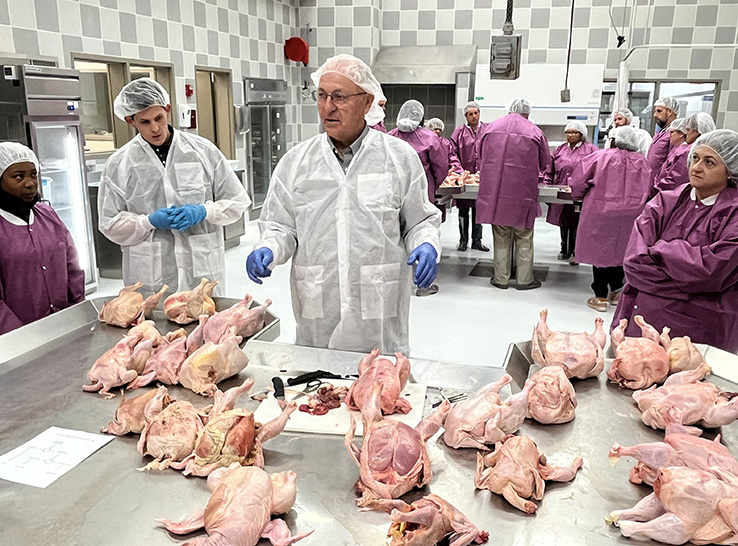Proper litter management is a key factor in controlling Salmonella on the farm. Zac Williams, PhD, assistant professor of poultry management at the University of Arkansas, addressed this topic at the Delmarva Chicken Association’s 59th National Meeting on Poultry Health, Processing and Live Production.
Considering proposed new Salmonella regulations, he stated that service technicians and growers will likely be “on the frontlines of Salmonella control” on farms.
Williams noted that Salmonella has been found “everywhere,” including on walls, feedlines, dust, equipment, rodents, darkling beetles and flies. Those houseflies, for example, can travel 10 miles. Since modern poultry farms are bunched closely together, houseflies can easily be Salmonella vectors at multiple farms.
Broiler litter alone is “home to billions of bacteria,” most of which are good and serve to break down the matter, Williams explained. The remainder, however, contains diseases like those he terms “the big three”: Salmonella, Campylobacter and Clostridium perfringens.
Litter promotes bacterial growth because “it gives them everything they need” to grow: moisture, nutrients from birds’ excreta and warm temperatures. Of these three, moisture is the only one that can be controlled. In his presentation, Williams focused on ways to control the moisture in litter.
Steps before placing flock
Williams first outlined three steps to reduce bacteria in the litter before the flock is placed on the farm: removing the wet litter, preheating the house and moving the air.
For the first step, go under the waterlines and remove any wet, caky litter, he advised. Next, preheat the house to dry out the litter. Finally, ensure adequate air movement, which “is the single best way to dry anything out,” he said, adding that proper ventilation is the best way to get air movement indoors.
Proper ventilation involves moving air along the ceiling rather than on the floor. If cold, moist, humid air is on the ground, “it’s going to make it rain inside that house essentially…and you’re going to get wet litter,” Williams noted.
He described a brooding house with a string of wet litter because the air inlets were completely open and sending air to the floor. The service technician believed he could dry it out over a few months, but Williams said, “He’ll never dry that out.”
Proper inlet openings are 1.5 to 2 inches (3.8 to 5 cm) for sidewall inlets and 1.25 inches (3.2 cm) for ceiling inlets. Sidewall inlets should be aimed up because ceiling inlets are aimed down. Ceiling inlets should be closed more to allow more air to head toward the ceiling.
Humidity must also be controlled as warmer air carries more moisture.
Growout phase recommendations
During the growout phase, Williams said that wind speed in the barn is the key to keeping litter dry. He recommends at least 600 feet (183 m) per minute of wind speed down the center aisle, noting that as the speed is slower along the edges, the litter there will be wetter.
Regarding cooling pads or evaporative cooling cells, they should not be turned on until the air in the house hits 85° F (29° C) or even higher if the house has sprinklers. He explained that these cells or pads provide “evaporative cooling, not waterfalls,” so they should be run on a timer to allow the water to evaporate into them between “on” cycles. Generally, they should be turned on at 10 a.m. and off at 6 p.m. in the South because those are the times when humidity and temperature change.
Williams also stressed the importance of regularly checking water lines for leaks during the growout phase, as “leaks become lakes very quickly.”
He summarized that moisture control comes down to proper ventilation by moving air along the ceiling and with enough wind speed during growouts to keep the litter dry.
Windrowing significantly reduces bacteria
Along with moisture control, Williams recommended windrowing litter, noting that research shows “a significant reduction in bacterial populations” when it is done properly, with Salmonella decreased from 10 to zero logs, Campylobacter to zero and Clostridium perfringens also significantly down.
Windrowing, or turning the litter pile inside out, helps conserve moisture and heat in the pile. It also ensures that the entire pile is heated uniformly because the inner core heats more quickly while the outside is cooler.
“The single most important aspect to remember for windrowing is to monitor the temperatures,” Williams said. The ideal temperature range is 130° F (54° C) to 145° F (63° C). Otherwise, you just “paid a lot of money for someone to come in and pile litter,” because lower temperatures provide an ideal environment for bacterial growth.
A 3-foot (0.9 m)-long combination thermometer should be used, with temperatures taken from the inner core of the pile. Readings should also be taken from multiple locations at the same time every day “to ensure that the whole pile is heating,” as a 600-foot (183 m)-long windrow will have different temperatures from one end to the other, and temperatures can fluctuate throughout the day.
The piles should be turned only once the proper temperature has been reached, so this may change from day to day depending on the changing temperatures.
Chemical litter amendments help kill bacteria
Williams also discussed how chemical litter amendments like acidifiers can reduce litter pH. Acidifying the litter helps kill all the bacteria in those piles, including the big three.
He has seen some farmers try to save money by using only half the recommended amendment, but then the pH drop is “more neutral” and creates “a perfect environment” for bacteria. So Williams stressed that amendments must be used only at their recommended rate.
Williams also highlighted the importance of proper biosecurity and an integrated pest plan in helping control bacteria on the farm. Darkling beetles, for example, can carry Salmonella, so an effective pest plan must address them.
Regarding biosecurity, he emphasized that the proper location of footbaths is key to preventing the spread of bacteria. He mentioned a farm he had visited where the footbath was in a corner of the control room. So once workers stepped in it, they walked outside 20 feet (6 m) to the main barn, picking up anything on that stretch of ground, including bacteria.
Key takeaways
Williams concluded by stressing that Salmonella is everywhere. His overarching message is moisture control. Keeping the moisture rate in litter to 15% to 20% is “very easy to maintain” and cuts the bacteria’s survival time from weeks to hours.
Moisture control, along with windrowing, pest management and biosecurity, will keep bacteria like Salmonella off the farm.
He added that farms should also determine how to independently test and verify that the products they buy and use are working. “The salesman told us it was working” is not that verification, he concluded.








